|
NEWSLETTER of DAVID E. SMITH PUBLICATIONS, LLC
VOL 1, NO. 1, AUGUST 1, 1999
(c) 1999 Copyright of David E. Smith Publications
All Rights Reserved. Made in U.S.A.
Table of Contents
Publisher's Space
Editor's Space
Arrangers's Space
The Value of A Whole Note
Thinking...
Meet Dana Everson
Brass Space
String Space
Percussion Space
Woodwind Space
Your Space
Take Time
Humor Space
Welcome to the first issue of LINES & SPACES, the newsletter of the David E. Smith Publishing Company, Deckerville, Michigan.
Here are our objectives:
PUBLISHER'S SPACE
David E. Smith
- To promote awareness of new products and policies
- To stimulate thought concerning the necessities and beauty of sacred instrumental music
- To be a pedagogical helper
He welcomes your reactions and responses.
Phone 810.376.9055
Email despub@greatlakes.net
Fax 810.376.8429
To Table Of Contents To Table Of Contents OLD WINE IN NEW WINESKINS?--One of my personal goals is to take standard, well-loved hymns and freshen them up. I am not talking about changing the theology. I am not talking about simply adding a rhythm section beneath the melody.(Sometimes I think that can be a real cop-out...a poor substitute for real creativity.) I am talking about looking at the melody and words and trying to capture the intent and the message of the song by varying the harmony, color, rhythm, and so on. I am talking about carefully and reverently balancing the message of the music with the form that it takes. A certain melodic integrity must remain inviolable, for example, yet there is room for appropriate variation which might enhance the performance.
EDITOR'S SPACE
Harlow E. Hopkins
THE LONE ARRANGER'S SPACE
Dana F. Everson
As an arranger, I often will sit at the piano and play through a hymn over and over, as if I were looking at a diamond's many facets. I try to imagine the world that each little facet creates visually. Those facets in a melody involve the rise and fall of pitches, the points of tension and relaxation, the phrasing, and the mood and atmosphere of the words and the tune as a whole. I once heard a rock band play the old love song Tenderly. But they played it with a raucous, brash sound completely opposite to the character of the song! It would have been funny if it weren't so tragic!
I believe that true creativity operates quite comfortably within given limits. Indeed, it would seem that J.S. Bach deliberately limited himself in his use of style. He did not introduce new forms in his career, nor was he on the "cutting edge" of contemporary music of his day, (although he did perfect some forms, including the fugue) yet he must be considered one of the greatest creative geniuses of all time. That creativity is more appreciated when we realize both the self-imposed as well as the unalterable limitations placed on him from without. In a sense, writers today will have a harder time demonstrating true creativity since there are so many more tools/instruments/technologies available to them today than to Bach. All countermelodies have not yet been written that would work with Amazing Grace. All possible colors have not yet been explored with traditional instruments and their combinations. This is one of the goals of David E. Smith Publications, by the way, to provide a wide variety of instrumental color combinations for a wide array and assortment of needs of churches and schools. The challenge for the arranger is to overcome some of the technical problems of instrumentation in order to produce useful and effective presentations of the hundreds, no, thousands of hymns and gospel songs that can be used to build up the saints of God! I think God is like this, and I think His Word is like this. There are many colorful facets to be discovered within appropriate borders. The composer/arranger ought to be a reverent and humble imitator of God's handiwork. As you can see, the creative artist has certain freedoms, but also some very serious responsibilities to truthfully and carefully represent a miniature model of God's creative processes. It is a wonderful challenge indeed!
To Table Of Contents
Preach Christ Always --and as a last resort use words. St. Francis of Assisi
Just think ...how boring it would be to spend life as a WHOLE NOTE. There would be no stems to point the way. No flags for decoration. And very few markings that give you a chance to stand out as an individual. Mostly, you just sit there like a big old blob that just takes up space. And not even all of that because you have a great big hole in your big fat middle.
THE REAL VALUE OF A WHOLE NOTE
Alan S. Moss
What would happen if the WHOLE NOTE became an endangered species? -- We could fill in with a half note -- tied to a quarter -- tied to an eighth -- tied to a sixteenth -- tied to a ... In this case there would be plenty of stems "to point the way" and enough flags to decorate both the Democratic and Republican Conventions. Or we could use a half note with five or six dots followed by some interesting rests with lots of flags.
Does the WHOLE NOTE have any value? Yes! Many times above and beyond all other notes. Not just because of time length and har- mony; but, due to positive attributes, to rhythm and melody.
WHOLE NOTES as melody? Gimme a break! Right! The most famous and number one favorite Christmas song starts with a WHOLE NOTE. The song of course is White Christmas. Another famous melody is Thus Spake Zarathustra widely known as the Space Odessy 2001 which is a whole series of WHOLE NOTES.
So... What is the problem with WHOLE NOTES? The problem is that the performer normally cheats the WHOLE NOTE of its full value; or fails to keep a good tone throughout its duration. Young students and even many seasoned performers seem to think that it is boring or (heaven forbid) a "waste of time" to play such a long note. While quality musicians not only play the WHOLE NOTE full value but, learn to carry it all the way to the next measure. And instead of allowing the tone to weaken or die, the real musician will "do something with the note".
What can you "do" with a WHOLE NOTE? You cannot save them for a rainy day. You cannot give them away as Christmas presents. You cannot eat them for a snack. But, you can make music with WHOLE NOTES even if it is the hardest note to play.
WHOLE NOTE "do" list
DO...
- start with a good tone
- Hold out for full value
- balance volume with ensemble
- play in tune
DO MORE ...
- long gradual crescendo (contrary to weaken and die)
- careful decrescendo (as music permits)
- swell (crescendo then decrescendo)
- or the reverse (decrescendo then crescendo)
DO EVEN MORE... Make the WHOLE NOTE the most important or at least the most perfect note that you perform.
Consider the mathematical facts. If you miss a sixteenth note that is a mere fraction of a WHOLE mistake.
Alan Moss lives in Palm Bay, FL. He taught instrumental music in St. Louis, Missouri, for twenty-five years. He is a graduate of Olivet Nazarene University and a student of several outstanding brass players including Susan Slaughter and Edward Kleinhammer. Mr. Moss is currently a freelance composer and performer.
To Table Of Contents The word "standard" is fairly common in our conversations and several standards directly affect your life and mine. Some which come to mind most readily are: gold standard, silver standard, standard pitch, standard deviation, standard of living, Standard Oil, Central Standard Time, standard poodle, academic standards, standard bearer... STANDARD BEARER--after all the sermons have been preached and devotional talks given--describes the Christian.
THINKING...
Harlow E. Hopkins
My college Alma Mater contains a phrase which caught my attention a few months ago, as it never had before..."for noble standards which we'll hold 'til ending of our days."
For the Christian, standards are a part of the fabric of life. We "put them on", if you will, like clothes and we wear them for the length of our service to God. They're "designer clothes" and they bear the label: "Created by God."
In terms of their specialness they are like what we used to call "Sunday clothes," the clothes which we wore to church and rarely any other place. However in this case these "designer clothes" are worn seven days a week. They never wear out or become worn looking, are always well pressed and never go out-of-style. They have, in fact, been in style for thousands of years. In reality we are not only standard bearers but also standard wearers.
The standards set forth by our Creator -- goodness, righteousness, kindness, patience, gentleness, self-control, honesty, loyalty, obedience, truthfulness, faithfulness, dependability, service to God and others before self, etc., are examples of the standards which should characterize our lives.
With God's help through the Holy Spirit we bring honor to HIM as we wear these standards throughout a lifetime of Christian service.
To Table Of Contents To Table Of Contents Oral Cavity: Produces the Openness of Sound (vs. pinched/tight quality)
MEET DANA EVERSON
Dana F. Everson spent twenty-two years as an Assistant Professor of Music at Delta College, a community college in Mid-Michigan.
This summer he and his wife and five children are moving to Wisconsin, where he will be teaching at Northland Bible College. We wish him well in his new assignment.
He holds an Associate of Arts degree (Delta College), Bachelor of Music Education degree (Michigan State University), Masters Degree in Applied Saxophone (Michigan State University), and Masters of Sacred Music (Pensacola Christian College). He has additional credits in music from the University of Michigan, and from the University of Disneyland.
Mr. Everson has over 125 published sacred instrumental arrangements with David E. Smith Publications. He has also composed and arranged for band, choir, and various other ensembles. His responsibilities at Delta College have included Band, Music Theory, Music History, Music Appreciation, Elements of Music, Introduction to Composing, Class Piano and private teaching on several instruments. His other work experience has included arranging for the Michigan State University marching and concert bands, and a summer as a performer in the Disneyland All-American band.
He is actively involved as a conductor, clinician, and church pianist. Everson has also developed workshop and seminar material on philosophy of music, arranging for church musicians, and improving keyboard skills for church musicians.
BRASS SPACE
Phil Norris
Horizontal: Overbites and Underbites distort the airflow, adversely affecting timbre and resonance. Overbites should be corrected by shoving the lower jaw out to align with the top jaw. If there is a large amount of overbite, the correction will take some conscious work. First, set the horn (mouthpiece) on the TOP lip, then move the lower jaw out to meet the mouthpiece (the instrument can have a little downward angle). Watch that the player doesn't tilt the head back to achieve this. The head should be level and the eye straight forward. The player should feel about equal amounts of mouthpiece contact on both top and bottom lips (or slightly more on the top). If overbites are severe and not correctable, orthodonture should be sought.
UNDERBITES make brass playing very difficult if not impossible, because the jaw in this position constantly directs the air upward and away from the lower lip. This reduces full resonance of the sound which requires both lips to function. Potential players with underbites should be steered to other instrument families, but if brass is desired, tuba is the best option because of the amount of opening the mouth has for playing tuba. Yet, the lower register of the tuba will always be poor.
Orthodonture is the only solution for underbite problems. Players with perfect occlusion can play brasses well. In their low register, there will be less amount of jaw pivot*** compared with players who have overbites. Register shifts will be done mostly with lip changes and with relatively little jaw shifting. The jaw should always be flexible, not stiff or rigid.
*** JAW PIVOT--A jaw shift must occur between the two lowest tones of each brass instrument. Pivots are done by slurring downward from the upper to the lower note (e.g. concert F to Bb) and working the same thing through all valve combinations/slide positions.
Vertical: Jaw (lips) must be open to a maximum for any note played. Experiment with the "Drunken Exercise" - play around with the open end of the jaw setting. This will cause the pitch to bend down and up; the result should be a more flexible jaw that will stay open to a maximum throughout the playing process. But set the jaw by the sound NOT the other way around. The sound to the player should always be clear, ringing, full and buzzy or vibrating. The blowing should always be free and the air wasted.
The jaw must pivot open for the lowest natural note on each brass instrument. To play pedal tones (tones below the natural range of the instrument) additional pivots must be done. Pedal tones can be introduced after the first year (or sometimes before). Encourage young players to extend the drunken exercise lower and lower into the pedal range, increasing the amount and flow of air and letting the buzz be looser. The quality (niceness) of tone in the pedal register is not important. The loose buzz and free flow of air are. A benefit of pedal tones is increased strength to the upper register. The lips should feel OPEN and blown outward toward the mouthpiece so that a full buzz of the lips occurs and everything inside the mouthpiece buzzes.
Oral Cavity Vowel Shapes for each brass instrument are built around: Trumpet & Horn--Oo; Trombone/ Baritone--Oh; Tuba - Ah/Oh.
Within each instrument, the vowels (shape of the oral cavity) equate to "largeness" of sound. In this way any vowel can be used in any register (e.g. Ee in the low, Ah in the high). But generally, the lower the note, the more open the oral cavity and its vowel shape. Lower notes are shaped Ah/Oh, middle notes are shaped Oh/Oo, and high notes are shaped Oo/Ee. This is especially helpful when playing ascending lip slurs. Focusing on vowel shifts helps these slurs a great deal. When doing ascending slurs (lip or scale) it helps to increase the air flow as well as make vowel shifts.
Lastly, it's important to maintain the lower jaw's position (out) for all notes, but especially for high register notes.
Part II will explore the roles of embouchure and respiration on tone.
Phil Norris resides in Minneapolis Minnesota. He is an Associate Professor of Music at Northwestern College where he teaches and actively performs on trumpet. This past spring he completed a Doctor of Musical Arts degree at the University of Minnesota. Phil is a former president of the Christian Instrumentalists and Directors Association and continues to compile and edit the CIDA's Sacred List of Instrumental Music.
To Table Of Contents
Steps to Sharpen Your String Intonation! --
In our experience as music educators, guest conductors and performers, there are few musical problems more recurrent than faulty string intonation. Pure intonation is the sine qua non of good string tone, and it is the foundation upon which to build all other musical elements. One of the challenges for those of us who work regularly with string instrumentalists in churches and schools is to present a consistent expectation of good intonation in every lesson, rehearsal and performance.
STRING SPACE
Jay-Martin Pinner
Expectations of good intonation begin with the first lesson or rehearsal. From a practical standpoint all first-year and many second-year string students should have tapes or dots marking the correct finger placement on the fingerboard. This helps each student to develop a visual as well as an aural and kinesthetic response to good intonation. (This also prevents teacher/ conductor burn-out from listening to out-of-tune students with no tapes for years on end!) These temporary "frets" can be cut from automobile pin striping tape which is readily available in a wide variety of colors to suit a player's personality.
The next important step towards good intonation is tune the open strings -- objectively and with care. Students should begin tuning their own strings no later than the third year of instruction. Until then the instruments should be tuned prior to the rehearsal by an adult musician or qualified older student helper. No amount of instruction on finger placement can overcome faulty tuning of open strings. When working with young groups, teach students how to hear the "beats" between pitches that are not in tune.
Have students sing open string pitches on a neutral syllable ("la") to help them hear the correct open string pitches. Have the entire group sing lightly on pitch and signal half of the group to slide flat or sharp to illustrate beats. Have the students repeat the exercise with their instruments and explain that they are hearing increased resonance when everyone plays exactly in tune.
For intermediate and advanced groups the director should establish a system of tuning for every rehearsal. After tuning symphony winds, brass and percussion instruments following the standard procedures of a professional orchestra, an A-440 should be played for the cellos and basses. This allows bassists to clearly hear the pitch and check harmonics before the upper string sections begin tuning. Bassists need to take special care to be sure that their section, the foundation of the string choir, is in tune. Players should allow the tuning pitch to sound for several seconds before beginning to match it bowing softly, at a pianissimo level. Another A-440 should be sounded for the violins and violas, again with silence preceding the matching of pitch and tuning taking place at pianissimo. For improving a string group's intonation, tuning open strings is the most important event of the rehearsal. Until a group can do this quickly and accurately, the director should take time to hear the entire group play each open string, one at a time, together in unison.
String players should think pitches, and "mentalize" the location on the fingerboard and the sound to be produced before a finger touches a string. Let it be known that in your group string players are allowed, even encouraged, to adjust pitches by sliding the finger forward or backward on the fingerboard to compensate for pitches that sound flat or sharp. To help individuals without embarrassing them, have them play as a quartet or as stand partners to monitor their own "intuneness."
One of the most subtle steps for improving the level of intonation in a group is teaching students to listen and adjust for specific scale degrees and intervalic relationships. This "expressive intonation" is one of the marks of the group that is moving beyond merely "playing the right notes." It is quite possible to hear expressive intonation at the middle school level, but it is imperative that high school, college and church groups understand this concept. begin with teaching the scale degrees, emphasizing the tonic, the dominant, the leading tone and the mediant. Explain the basics of chord structure. Then, for example, the director may say, "Violas, you have the third of that D Major chord. Remember that sharped thirds need to sound high. Bring out the F# and push the second finger higher on the D string. It is the most important pitch in the orchestra right there..." "Violins, that G# is the seventh step in our key of A Minor, the seventh step of an A Minor scale. It will sound more in tune to all of us if you stretch your third finger on the D string and play it higher..." If possible demonstrate or have students demonstrate on string instruments rather than the piano. The fixed pitches of the piano do not allow for the range of expressive intonation that should be expected of string students. (Playing with a piano accompaniment demands its own type of expressive intonation since many of the intonation adjustments necessary for strings and winds are already built into the piano when it is tuned properly.)
Pinner's Practical Pointers for Preventing Prickly Problems with Penurious Pinkies:
- Have string players "test" pitches with the open string above or below the offending pitch. Let them slide gently until the pitch resonates in tune. This reinforces interval studies and double stopping.
- Physically check intonation of individual pitches with a tuner that shows how many cents sharp or flat a pitch actually sounds. Many players become convinced of careless intonation only after they see it on a meter!
- Record a student or a group. Listen critically to the playback together, pencil in hand, discussing and marking the music where intonation problems occur and what can be done to solve them.
- Have a student listen to recordings of great artists or play along with a recording.
- Have a student play chamber music with you or other students.
- When working with groups build chords slowly from bottom to top, helping students adjust pitches as a section. Have the section leaders play out (in tune!) at a dynamic of mezzo forte and allow the section to tune to that sound at piano.
The quest for a high standard of string intonation is not mysterious nor nebulous. It requires that music educators set the standard and maintain a consistent expectation that students will play in tune. Assume that "If my group plays out of tune it is my fault as the director." If sloppy intonation is allowed in our groups, players become satisfied with mediocrity. Like an unfeeling conscience that becomes seared to truth, they cannot hear the beauty of pure intonation that should always be there.
Jay-Martin Pinner is Head of the String Department and coordinator of the Precollege Orchestra Program at Bob Jones University in Greenville, SC. He has been a member of the Bob Jones University Symphony Orchestra for 28 years, and has appeared with that orchestra as concertmaster, soloist, principal violist, principal bassist and conductor.
To Table Of Contents Simplifying Percussion Parts Often existing percussion arrangements are such that they are not suitable for a particular level or group of performers. They may be too difficult for the individual or group to play or they may be too easy. When this occurs it may become necessary to rewrite the percussion parts to meet the needs of that particular percussionist or percussion section.
PERCUSSION SPACE
Billy Madison
In order to simplify parts that are too difficult there are certain "tricks" that can be used:
1. Take out flams, drags, etc.
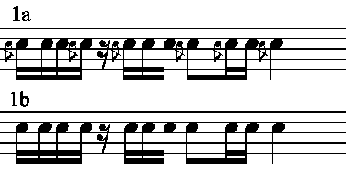
2. Replace sextuplets with sixteenth notes.
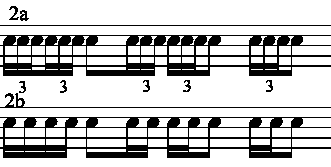
3. Take out rolls that may be difficult to play.
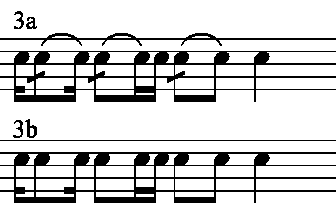
4. When there are sixteenth note patterns with complex accents, convert the sixteenth notes to the accented rhythm.
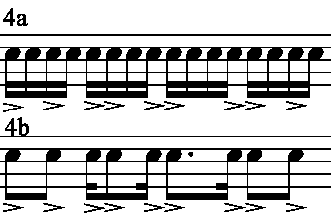
5. Reduce the amount of changing drums for multiple drum parts.
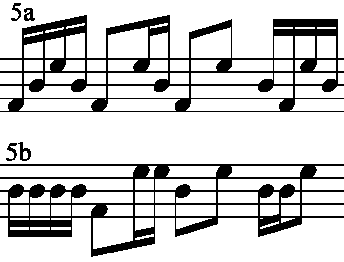
6. When there are sixteenth note patterns with slashes dispersed throughout the notes simply remove the slashes.
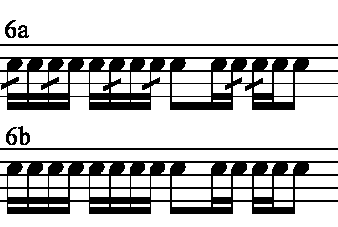
Obviously, there are many other things that can be done to simplify percussion parts. It is always important to maintain the integrity and overall concept of the music. The above suggestions are only a few of the more common methods. With more practice at making percussion parts easier to play, one will discover the "tricks" that work best for his or her personal style.
Billy Madison holds the BME (Instrumental Music), the MM (Music Theory and Composition) and the SCCT in music. All three degrees were taken at Arkansas State University. He has studied composition with Jared Spears and Tom O'Connor. Since 1978 Madison has with a percussionist with the Northeast Arkansas Symphony Orchestra and has taught instrumental music in the Arkansas Public Schools for fifteen years. He currently resides in Newport, Arkansas.
To Table Of Contents Some Thoughts on Articulation The correct use of the tongue to achieve "legato or staccato style" requires a good understanding of three concepts: (1) The position of the tongue. (2) The tongue movement itself. (3) The strength of the tongue.
WOODWIND SPACE
Harlow E. Hopkins
Using the consonant "d" to make legato connections has the effect of broadening the end of the tongue while using the consonant "t" points the tongue to best achieve the separation of sounds required in "staccato style" playing.
The vowel position, which follows, can vary. Some use "e" (as in "squeak") while others use "ih" (as in "did"). Still others use "o" (as in "dough") or "oo" (as in "due). These are by no means the only possibilities. The final choice should be the one which best achieves the desired result.
In the writer's experience, positioning the tongue slightly higher in the mouth helps when playing legato style. The tongue movement itself should be a slower, brushing or caressing movement, as opposed to the staccato style movement which is quick and darting in nature.
With some students it has helped to plant the idea of a somewhat circular motion for legato as opposed to a straight up-and-down movement for staccato.
The tongue possesses much greater strength than most of us realize. It can be forced against the reed in such a manner, or behind the upper teeth in the case of the flute, that any sort of good quality articulation is impossible.
Somehow the concept of using the smallest amount of tongue possible touching the smallest reed area must be instilled in the player.
The late Keith Stein, artist clarinet teacher at Michigan State University, states in his book, "The Art of Clarinet Playing," that the player should think of touching one granule of the tongue to one fiber of the reed. What a great analogy! It graphically describes what the player should attempt to do--whether playing legato style OR staccato style.
To summarize, a very small amount of tongue should touch a very small amount of reed, (or teeth, flutists) at varying speeds using vowels, which begin with "t" or "d". The desired legato results will be sounds which are barely interrupted by the tongue whereas desired staccato results will be sounds which begin very incisively with the amount of separation depending on the note context.
Harlow Hopkins holds degrees from Olivet Nazarene University, American Conservatory of Music (Chicago), and a D.Mus. Degree from Indiana University, Bloomington. His teaching career took place at Olivet Nazarene University where he spent 42 years and conducted ONU Bands for 39 years. He retired in 1996 and continues to play clarinet, co-conduct a New Horizons Band and edit newsletters.
To Table Of Contents To Table Of Contents TAKE TIME
- Take time to Work - It is the price of success.
- Take time to Pray - it is the source of power.
- Take time to Play - It is the secret of youth.
- Take time to Read - It is the foundation of knowledge.
- Take time to Worship - It is the highway of reverence and washes the dust of earth from our eyes.
- Take time to Help and Enjoy Friends - It is the source of happiness.
- Take time to Love - It is the one sacrament of life.
- Take time to Dream - It hitches the soul to the stars.
- Take time to Laugh - It is the singing that helps with life's loads.
- Take time to Plan - It is the secret of being able to have time to take time for the first 9 things.
To Table Of Contents Seen on Church Sign Boards:
- "Free Trip to heaven. Details Inside!"
- "Try our Sundays. They are better than Baskin-Robbins'."
- When the restaurant next to the Lutheran Church put out a big sign with red letters that said, "Open Sundays," the church reciprocated with its own message, "We are open on Sundays, too."
- A singing group called "The Resurrection" was scheduled to sing at a church. When a big snowstorm postponed the performance, the pastor fixed the outside sign to read; "The Resurrection is postponed.
- "People are like tea bags-you have to put them in hot water before you know how strong they are."
- "God so loved the world that He did not send a committee."
- "Come in and pray today. Beat the Christmas rush!"
- "When down in the mouth, remember Jonah. He came out alright."
To Table Of Contents
Preach Christ Always -- and as a last resort use words. St. Francis of Assisi
You can receive a free subscription of the Newsletter in printed form by filling out the Order Newsletter...
Order Newsletter
|
HUMOR SPACE
YOUR SPACE
Do you have articles you wish to submit?. Feel free to do so. They will all receive consideration. Some of you may want to respond to the Newsletter by writing or e-mailing reactions. Letters to the editor are welcome! Please let us know what you think about this issue--positive or negative. Harlow E. Hopkins
697 Oak Run Drive
Bourbonnais IL 60914
Phone -- 815.933.6925
E-mail -- hhopkins@olivet.edu
Fax -- 815.933.1162
Basics of Brass Sound -- Part I I trust that this series will provide the reader with practical information and tips for successful brass tone production. The series will follow with material about the role of embouchure and respiration in brass tone production. DO WE NEED MORE ARRANGEMENTS?On the face of it, the answer seems obvious; we need new arrangements because we are done with the old ones. Could we suggest a few thoughts that go a bit deeper into the motivation behind creating new works? Publishing a newsletter has been a dream of Dave Smith's for several years. He has talked with more than one person about editing such a publication.
Several months ago he approached me on the subject. I had recently retired and he may have felt that I needed something to do in my spare time and being a good friend he came up with something for me to do. I was, and am, flattered. I've never taken "Editing Newsletters--101" and wonder about the wisdom of taking on an assignment such as this. But, it is a worthy project and will be published by a man of God who loves sacred instrumental music, as do I, so I'm honored to accept this new challenge. I do so seeking your prayers and understanding as we break new ground. In keeping with Dave's goals some of the "spaces" will be filled with "lines" provided by the following:
Dana Everson -- Arranging
Phil Norris--Brass
Jay-Martin Pinner--Strings
Billy Madison--Percussion
Harlow Hopkins--Woodwinds
In addition, arrangers and composers whose music is published by DESPUB will be introduced. Dana Everson is the first one to be introduced and the article appears on page three. [top]
|




